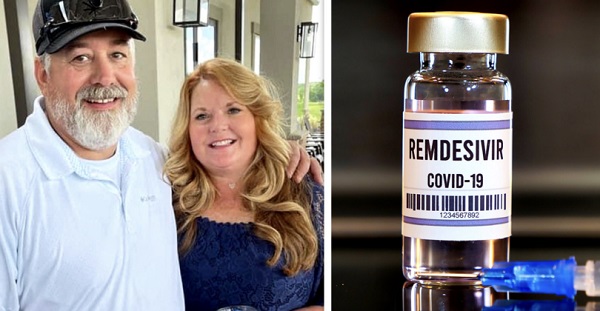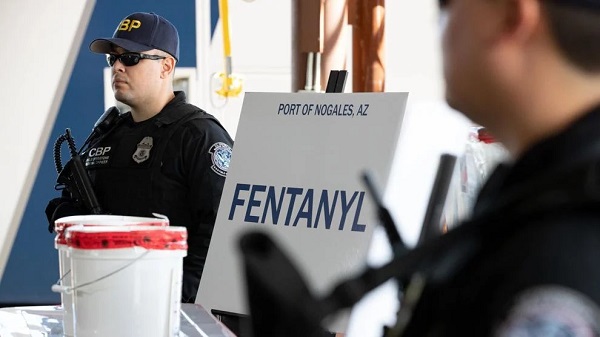COVID-19
‘They lied to us’: Wife of 53-year-old who died hours after receiving Remdesivir speaks out

From LifeSiteNews
By Michael Nevradakis Ph. D., The Defender
Shannon is trying to raise public awareness of the COVID-19 hospital protocols that she believes led to her husband’s death.
In August 2021, 53-year-old Michael E. Pilgrim and his wife Shannon had just celebrated their 29th wedding anniversary and were looking forward to their daughter’s marriage in October.
A former military service member and father of two, Michael was a “good husband and great dad” and enjoyed golf in his spare time.
However, Michael’s fortunes dramatically changed that month when he experienced difficulty breathing and a low oxygen level. On Aug. 17, 2021, he was admitted to Dallas Regional Medical Center, near his hometown of Forney, Texas, with a COVID-19 diagnosis.
Two days later, on Aug. 19, he was dead.
In an interview with The Defender, Shannon Pilgrim said that from the time Michael was admitted to the hospital, she and other members of her family were barred from visiting him and kept in the dark about the treatment he was receiving.
READ: 26% of those prescribed Remdesivir for COVID died, according to Medicare database
According to Shannon, Michael’s medical records showed that doctors barely offered Michael any treatment and emphasized his unvaccinated status. Treatments Michael received included the controversial drug remdesivir — administered hours before his death.
Today, Shannon is trying to raise public awareness of the COVID-19 hospital protocols that she believes led to her husband’s death. She shared extensive medical documentation with The Defender corroborating her story.
‘Contradictory’ medical records contained ‘many gaps’
Shannon recounted that she and Michael became sick at the same time, but she recovered. Meanwhile, Michael remained bedridden. Shannon said Michael was previously healthy and was not taking any medications, but his breathing difficulties “scared” her and led her to call 911 — a decision she now regrets.
“The worst thing that’s ever happened to me is calling 911,” Shannon said. “I thought that I was doing the best thing for Michael. I came to find out that was the worst thing.”
Michael was taken to Dallas Regional Medical Center, a hospital that “has a horrible reputation” according to Shannon. She accused the hospital of refusing her request for Michael to be transferred and did not let her see him after he was admitted.
Shannon said communication with the hospital was limited. “I would call and the nurses would tell me they were on shift change or were busy and couldn’t talk to me.”
Doctors’ interactions with Michael were also limited, Shannon said. “They were just leaving him in a room and they had an iPad popped in to ask him about medical stuff.”
According to Shannon, most of what she’s learned about Michael’s treatment came from the medical records she obtained after his death — even though the records “are completely just contradictory” and contain “many gaps.”
Shannon referred to an instance when a Dallas Regional doctor told her that Michael was doing well — while the records indicate that the doctor called her to say Michael was in critical condition.
Shannon said the records revealed that the hospital “did nothing” for Michael. She said:
On the first day, they basically didn’t do anything except give him oxygen. The next day, he had a chest X-ray and then doctors gave him vitamins … there’s contradictory stuff in here about whether he even had an IV. I can’t even get — from looking at his medical records — if they gave him fluid.
They started giving him Lovenox shots for blood clots. Why? He didn’t have blood clots … Then they started giving him insulin. Why were they giving him insulin? He wasn’t a diabetic.
But according to the medical records, they really didn’t do anything, and that’s what just completely floored me — except they gave him remdesivir.
Remdesivir, which has been linked to deaths and injuries in COVID-19 patients, was commonly administered to patients under the COVID-19 hospital protocols.
According to Shannon, the records indicate that Michael was administered remdesivir on the day of his death. But as she recalls, when she spoke to her husband on the phone that day at noon he showed no signs of being in danger.
“He called me, and I actually got to talk to him. I didn’t talk to him very long, but he wasn’t on a ventilator. He was better,” Shannon said. “I called my kids and I was like, ‘He sounded so good.’ I said, ‘He’s going to be coming home.’ I was so excited.”
Yet, that afternoon, Michael was given remdesivir. According to Shannon, the hospital called her a few hours later to say that Michael was found unresponsive.
“I got hysterical,” Shannon said. “I was asking again and again, ‘Is he OK? Where is he? How do I get in touch?’ … She wouldn’t give me her name. She just said, ‘I’m so sorry.’ She said he coded and they took him to ICU and ‘someone will call you tomorrow’ … And she hung up the phone on me.”
Shannon’s son called Dallas Regional and was told Michael had died. But the family’s difficulties did not end there, as the hospital did not allow them to see Michael’s body.
“We didn’t get to see him until he was embalmed, because they told us that he had COVID,” Shannon said.
Shannon said she believes her husband’s unvaccinated status played a role in the treatment he received. She said Michael had been “cautious” about the COVID-19 vaccine and reluctant to receive it — and that the hospital was aware of this.
“You see all through his medical records, ‘unvaccinated,’ ‘unvaccinated,’ ‘unvaccinated,’” Shannon said. “It’s even written in there, ‘doesn’t trust the vaccine.’”
‘They completely lied’
Shannon said the hospital stonewalled her and her family after Michael’s death.
“They wouldn’t talk to me, they wouldn’t take my calls,” Shannon said. “I kept calling up there and begging to have somebody tell me what happened and nobody would tell me.” The hospital then started pursuing her for unpaid medical bills, she said.
When she did speak to hospital personnel, they misled her. In one instance, she said a doctor told her that while she had the right to have an autopsy performed on Michael’s body, local authorities were “six to eight months behind” and that she’d have to wait that long for the body to be released.
“They completely lied, because later I found out that by law they have to do an autopsy within two weeks, and then it can be six to eight months before you actually get the report. But they have to do it and they have to release the body. But they lied to us and we trusted them,” Shannon said.
Instead, Shannon said the government-funded COVID-19 Bereavement Assistance Fund offered a $10,000 payout for Michael’s death. “They were giving up to $10,000 if the death certificate had COVID on it. And I said, ‘no way in hell will I take that payout.”
Instead, Shannon became an advocate for families that endured similar experiences, by joining the FormerFedsGroup Freedom Foundation. Through her involvement with this advocacy group, Shannon has met with legislators, attorneys and family members of other COVID-19 hospital protocol victims.
“It’s hard, but I don’t want other loved ones to go through what we went through,” Shannon said. “I realized that I want to keep fighting. And so, as hard as it is to keep reliving this timeframe, I will keep doing it … I don’t want people to think he died from COVID, because he didn’t. He died at the hospital because of them. They killed him.”
This article was originally published by The Defender — Children’s Health Defense’s News & Views Website under Creative Commons license CC BY-NC-ND 4.0. Please consider subscribing to The Defender or donating to Children’s Health Defense.
COVID-19
Trump DOJ seeks to quash Pfizer whistleblower’s lawsuit over COVID shots

From LifeSiteNews
The Justice Department attorney did not mention the Trump FDA’s recent admission linking the COVID shots to at least 10 child deaths so far.
The Trump Department of Justice (DOJ) is attempting to dismiss a whistleblower case against Pfizer over its COVID-19 shots, even as the Trump Food & Drug Administration (FDA) is beginning to admit their culpability in children’ s deaths.
As previously covered by LifeSiteNews, in 2021 the BMJ published a report on insider information from a former regional director of the medical research company Ventavia, which Pfizer hired in 2020 to conduct research for the company’s mRNA-based COVID-19 shot.
The regional director, Brook Jackson, sent BMJ “dozens of internal company documents, photos, audio recordings, and emails,” which “revealed a host of poor clinical trial research practices occurring at Ventavia that could impact data integrity and patient safety […] We also discovered that, despite receiving a direct complaint about these problems over a year ago, the FDA did not inspect Ventavia’s trial sites.”
According to the report, Ventavia “falsified data, unblinded patients, employed inadequately trained vaccinators, and was slow to follow up on adverse events reported in Pfizer’s pivotal phase III trial.” Overwhelmed by numerous problems with the trial data, Jackson filed an official complaint with the FDA.
Jackson was fired the same day, and Ventavia later claimed that Jackson did not work on the Pfizer COVID-19 shot trial; but Jackson produced documents proving she had been invited to the Pfizer trial team and given access codes to software relating to the trial. Jackson filed a lawsuit against Pfizer for violating the federal False Claims Act and other regulations in January 2021, which was sealed until February 2022. That case has been ongoing ever since.
Last August, U.S. District Judge Michael Truncale dismissed most of Jackson’s claims with prejudice, meaning they could not be refiled. Jackson challenged the decision, but the Trump DOJ has argued in court to uphold it, Just the News reports, with DOJ attorney Nicole Smith arguing that the case concerns preserving the government’s unfettered power to dismiss whistleblower cases.
The rationale echoes a recurring trend in DOJ strategy that Politico described in May as “preserving executive power and preventing courts from second-guessing agency decisions,” even in cases that involve “backing policies favored by Democrats.”
Jackson’s attorney Warner Mendenhall responded that the administration “really sort of made our case for us” in effectively admitting that DOJ is taking the Fair Claims Act’s “good cause” standard for state intervention to mean “mere desire to dismiss,” which infringes on his client’s “First Amendment right to access the courts, to vindicate what she learned.”
Mendenhall added that in a refiled case, Jackson “may be able to bring a very different case along the same lines, but with the additional information” to prove fraud, whereas rejection would send the message that “if fraud involves government complicity, don’t bother reporting it.”
That additional information would presumably include the FDA’s recent admission that at least 10 children the agency has reviewed so far “died after and because of receiving COVID-19 vaccination.”
“The truth is we do not know if we saved lives on balance,” admitted FDA Chief Medical Officer Vinay Prasad in a recent leaked email. “It is horrifying to consider that the U.S. vaccine regulation, including our actions, may have harmed more children than we saved. This requires humility and introspection.”
The COVID shots have been highly controversial ever since the first Trump administration’s Operation Warp Speed initiative prepared and released them in a fraction of the time any previous vaccine had ever been developed and tested. As LifeSiteNews has extensively covered, a large body of evidence has steadily accumulated over the past five years indicating that the COVID jabs failed to prevent transmission and, more importantly, carried severe risks of their own.
Ever since, many have intently watched and hotly debated what President Donald Trump would do about the situation upon his return to office. Though he never backed mandates like former President Joe Biden did, for years Trump refused to disavow the shots to the chagrin of his base, seeing Operation Warp Speed as one of his crowning achievements. At the same time, during his latest run he embraced the “Make America Healthy Again” movement and its suspicion of the medical establishment more broadly.
So far, Trump’s second administration has rolled back several recommendations for the shots but not yet pulled them from the market, despite hiring several vocal critics of the COVID establishment and putting the Department of Health & Human Services under the leadership of America’s most prominent anti-vaccine advocate, Robert F. Kennedy Jr. Most recently, the administration has settled on leaving the current jabs optional but not supporting work to develop successors.
In a July interview, FDA Commissioner Marty Makary asked for patience from those unsatisfied by the administration’s handling of the shots, insisting more time was needed for comprehensive trials to get more definitive data.
COVID-19
Canadian Health Department funds study to determine effects of COVID lockdowns on children

From LifeSiteNews
The commissioned study will assess the impact on kids’ mental well-being of COVID lockdowns and ‘remote’ school classes that banned outdoor play and in-person learning.
Canada’s Department of Health has commissioned research to study the impact of outdoor play on kids’ mental well-being in light of COVID lockdowns and “remote” school classes that, for a time, banned outdoor play and in-person learning throughout most of the nation.
In a notice to consultants titled “Systematic Literature Reviews And Meta Analyses Supporting Two Projects On Children’s Health And Covid-19,” the Department of Health admitted that “Exposure to green space has been consistently associated with protective effects on children’s physical and mental health.”
A final report, which is due in 2026, will provide “Health Canada with a comprehensive assessment of current evidence, identify key knowledge gaps and inform surveillance and policy planning for future pandemics and other public health emergencies.”
Bruce Squires, president of McMaster Children’s Hospital of Hamilton, Ontario, noted in 2022 that “Canada’s children and youth have borne the brunt” of COVID lockdowns.
From about March 2020 to mid-2022, most of Canada was under various COVID-19 mandates and lockdowns, including mask mandates, at the local, provincial, and federal levels. Schools were shut down, parks were closed, and most kids’ sports were cancelled.
Mandatory facemask polices were common in Canada and all over the world for years during the COVID crisis despite over 170 studies showing they were not effective in stopping the spread of COVID and were, in fact, harmful, especially to children.
In October 2021, then-Prime Minister Justin Trudeau announced unprecedented COVID-19 jab mandates for all federal workers and those in the transportation sector, saying the un-jabbed would no longer be able to travel by air, boat, or train, both domestically and internationally.
As reported by LifeSiteNews, a new report released by the Justice Centre for Constitutional Freedoms (JCCF) raised alarm bells over the “harms caused” by COVID-19 lockdowns and injections imposed by various levels of government as well as a rise in unexplained deaths and bloated COVID-19 death statistics.
Indeed, a recent study showed that COVID masking policies left children less able to differentiate people’s emotions behind facial expressions.
COVID vaccine mandates and lockdowns, which came from provincial governments with the support of the federal government, split Canadian society.
-

 Censorship Industrial Complex2 days ago
Censorship Industrial Complex2 days agoDeath by a thousand clicks – government censorship of Canada’s internet
-

 Alberta2 days ago
Alberta2 days agoSchools should go back to basics to mitigate effects of AI
-

 International2 days ago
International2 days agoAt Least 15 Killed In Shooting Targeting Jewish Community At Australia’s Bondi Beach, Police Say
-

 Daily Caller2 days ago
Daily Caller2 days agoChinese Billionaire Tried To Build US-Born Baby Empire As Overseas Elites Turn To American Surrogates
-

 Great Reset2 days ago
Great Reset2 days agoViral TikTok video shows 7-year-old cuddling great-grandfather before he’s euthanized
-

 Business2 days ago
Business2 days agoMajor tax changes in 2026: Report
-

 International2 days ago
International2 days agoRussia Now Open To Ukraine Joining EU, Officials Briefed On Peace Deal Say
-

 Crime1 day ago
Crime1 day agoTrump designates fentanyl a ‘weapon of mass destruction’


